Posted by: Northwest Eye in General on August 6, 2025
Overview
As a caring parent, recognizing the main signs of glaucoma in your child is crucial. These signs include:
- Blurred vision
- Increased eye pressure
- Peripheral vision loss
- Sensitivity to light
Each of these symptoms can indicate serious eye health issues that deserve attention. We understand that it can be concerning to think about your child’s eye health, which is why regular eye exams are so important. They allow for timely detection and management of these symptoms, helping to prevent irreversible vision loss.
It’s common for many children to remain undiagnosed without proactive screening. By prioritizing eye exams, you can ensure your child receives the care they need. Remember, we are here to help you through this process and support your child’s vision health.
Introduction
Recognizing the signs of glaucoma in children is crucial, and we understand that many parents may feel unaware of the subtle indicators that can lead to significant vision loss. With approximately 4.22 million individuals in the U.S. affected by this “silent thief of sight,” understanding the early symptoms can empower you to seek timely intervention.
It’s common to wonder: what if the blurred vision or headaches that seem trivial could actually signal a serious eye condition? This article delves into nine key signs of glaucoma that every parent should be vigilant about, ensuring that your child’s eye health is prioritized and protected.
Northwest Eye: Comprehensive Eye Exams for Early Glaucoma Detection
At Northwest Eye, we understand how important it is to prioritize your . play a crucial role in the of and other eye pressure conditions. These assessments include:
- A detailed evaluation of intraocular pressure
- Visual field tests
- Optic nerve analysis
are vital, as they can uncover signs of glaucoma and other changes in your eye health before symptoms escalate, allowing for timely interventions tailored to your individual needs.
It’s common to feel uncertain about eye health, especially since statistics reveal that , such as signs of glaucoma, are unaware of their situation. In fact, over 4.22 million people in the U.S. are affected, underscoring the importance of regular eye examinations. As one specialist wisely noted, “The sole method to detect signs of glaucoma in its initial stages is through a thorough eye examination.” By prioritizing these assessments, you can significantly enhance your chances of receiving a prompt diagnosis and effective management of signs of glaucoma, which ultimately helps to preserve your vision.
Moreover, with this eye condition costing the U.S. $2.86 billion each year in medical expenses and lost productivity, not just for your health but also for broader economic considerations. We encourage you to arrange your today, especially if you are over 40 or have a family history of eye disease. Remember, we are here to help you through this process.
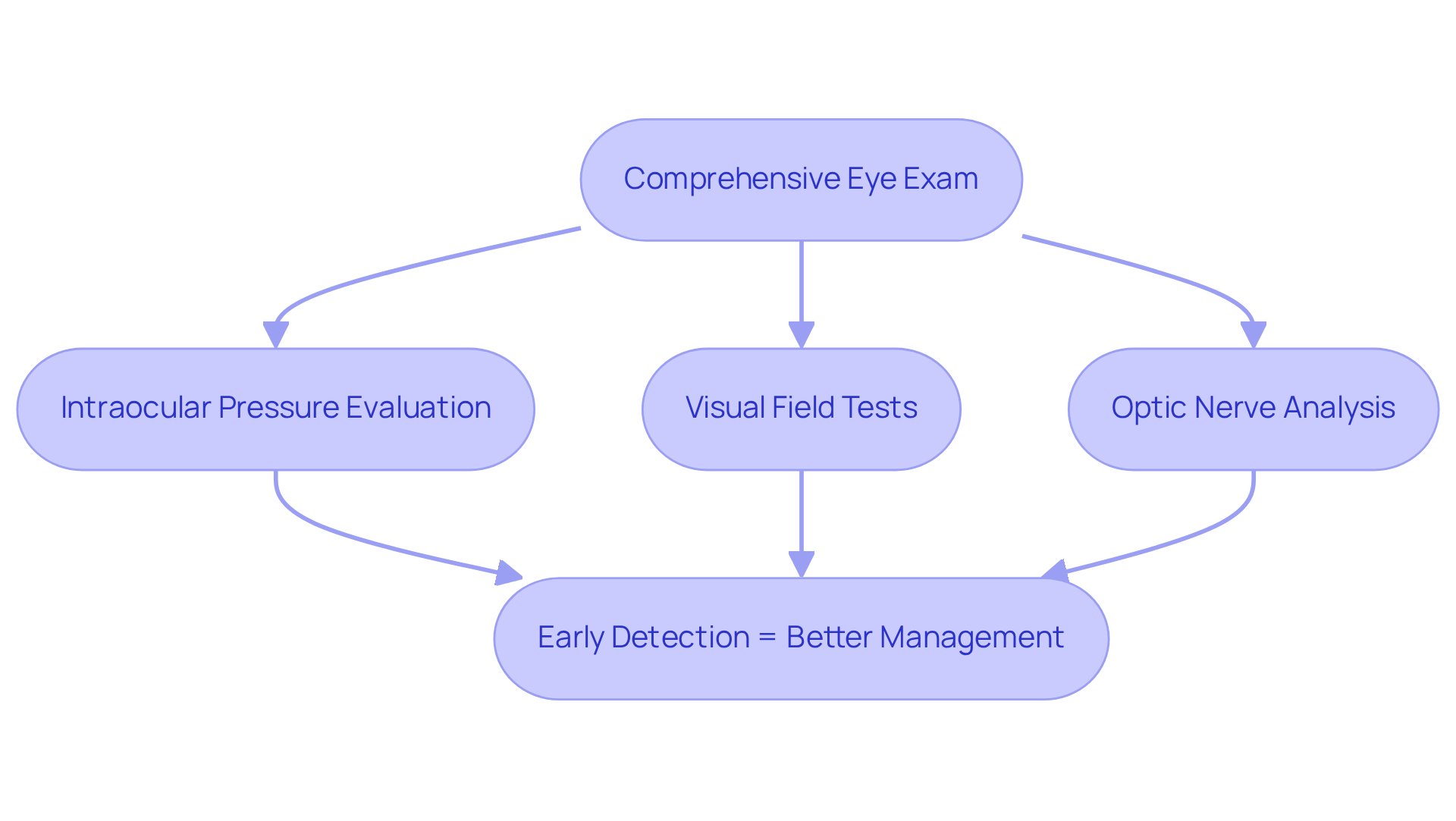
Blurred Vision: A Key Early Indicator of Glaucoma
is often one of the first and other eye diseases, particularly in children. It can arise from elevated intraocular pressure affecting the optic nerve. As parents, we understand how concerning it can be to notice any difficulties your child may have in concentrating or seeing objects clearly. These symptoms may indicate signs of glaucoma and other that require attention.
Research shows that around 3 million people in the U.S. are affected by glaucoma, and alarmingly, many cases remain undiagnosed, especially among younger individuals. Unclear sight in children can be a critical warning sign that necessitates . Experts emphasize the , as prompt intervention can help prevent further damage to the optic nerve.
The prevalence of blurred vision in young patients highlights the need for . Identifying issues early is vital for effective management. Ignoring these signs could lead to permanent vision loss, making it essential for parents to seek medical advice if their child experiences any changes in vision.
Glaucoma is often called the ‘,’ which underscores the stealthy nature of this condition and the urgent need for vigilance in recognizing the signs of glaucoma. Additionally, the is significant, reinforcing the importance of early detection. We are here to , ensuring that your is protected.
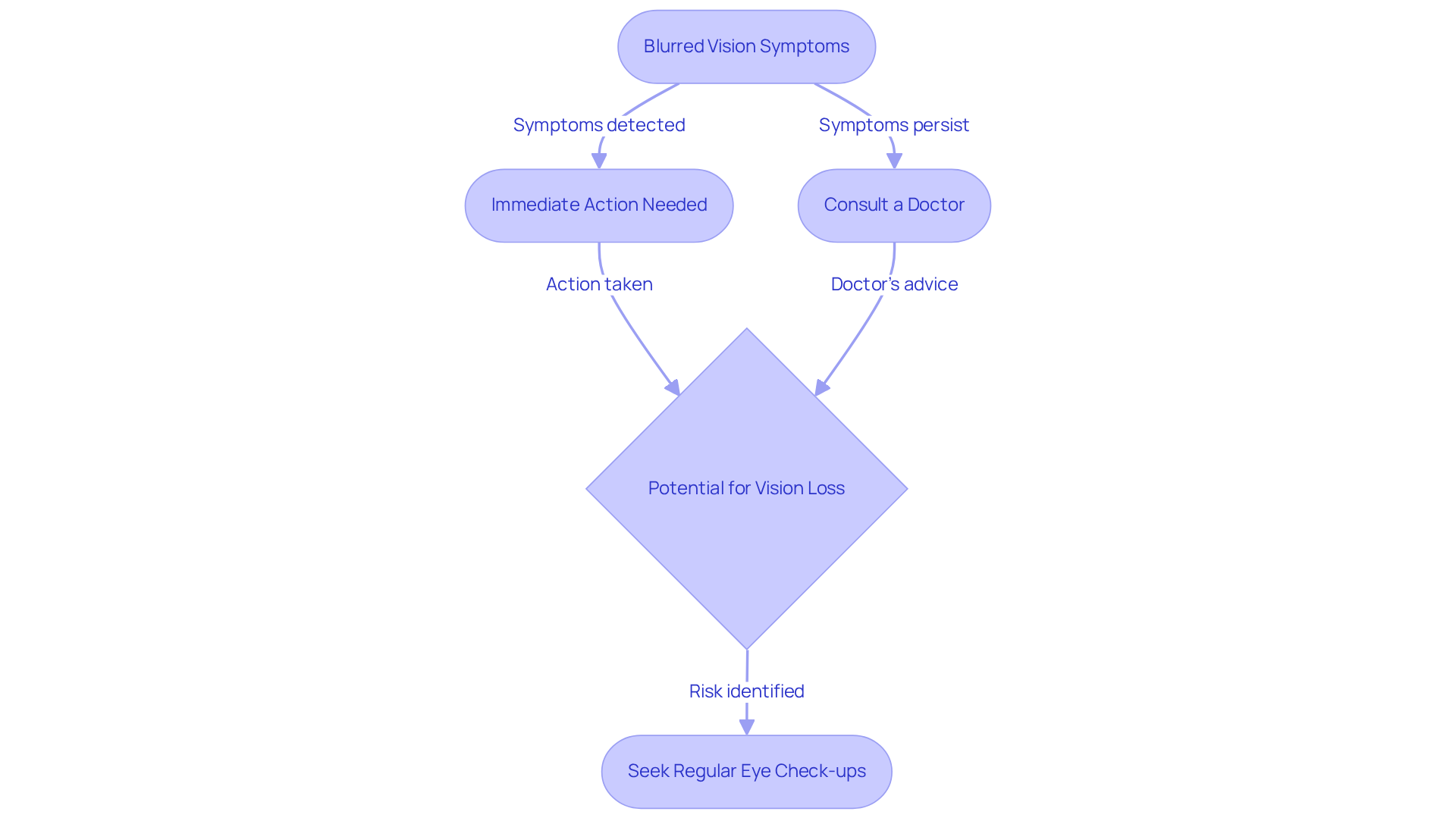
Increased Eye Pressure: A Critical Sign of Glaucoma
(IOP) is an important sign of glaucoma, particularly for young individuals. At Northwest Eye, we understand how vital are, which include —a test that accurately measures IOP. Research indicates that early-onset eye disease occurs in 1 in 43,575 individuals in the US population. A significant number of youngsters diagnosed with this condition show due to elevated IOP, underscoring the importance of .
Routine eye examinations are essential, particularly for . They allow for early intervention and effective management of potential issues. The role of tonometry in detecting eye conditions is crucial; it provides insights that help ophthalmologists identify potential problems before they escalate. As specialists remind us, ” enhances the outlook in the progression of the eye condition.”
It’s important to note that can occur in 1.2 to 7.1% of untreated pediatric cases of this eye condition. This highlights the need for parents to prioritize these to safeguard their children’s eye health. We are here to help you through this process, ensuring your child’s vision remains a priority.
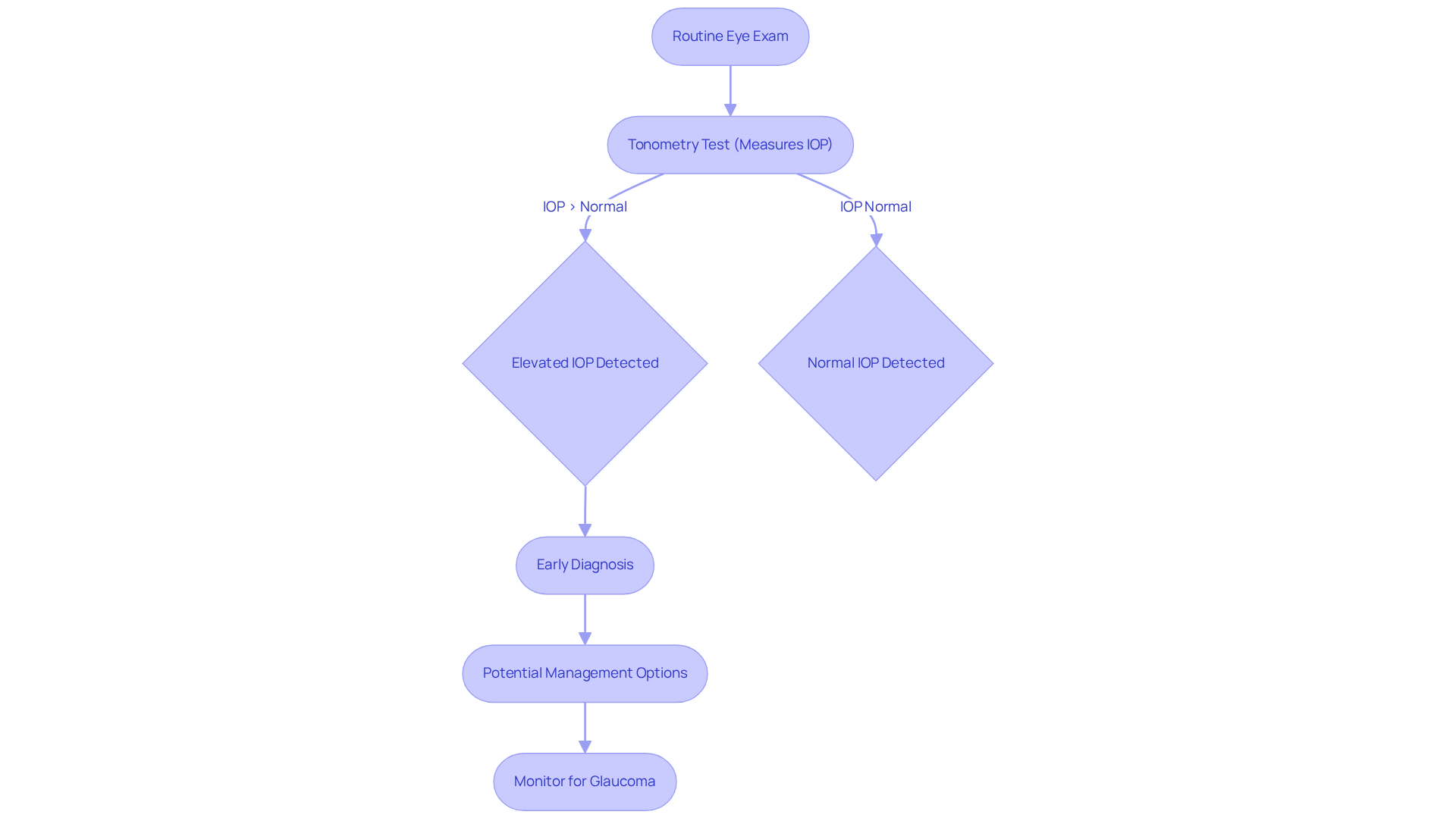
Peripheral Vision Loss: An Early Warning Sign of Glaucoma
is often one of the first signs of , typically affecting side vision before impacting central vision. We understand that as a parent, it can be concerning to see your child struggle with seeing objects to the side or frequently bump into things in their surroundings. This subtle change can be a .
Routine visual field examinations are essential for , as they can reveal these changes before more significant vision loss occurs. Research indicates that nearly 50% of individuals with eye disease remain unaware of their condition due to the absence of initial symptoms. Furthermore, approximately 60% of those diagnosed with the eye disorder will eventually experience some vision loss. This highlights the .
By 2040, glaucoma is projected to affect 111.8 million individuals globally, underscoring the urgent need for awareness and prompt detection initiatives. In real-world scenarios, early identification through has proven effective in managing the condition. This allows for timely intervention and care to preserve sight.
By recognizing these signs and understanding the significance of regular eye examinations, parents can play a vital role in safeguarding their children’s . We are here to , ensuring your child’s vision remains bright and healthy.
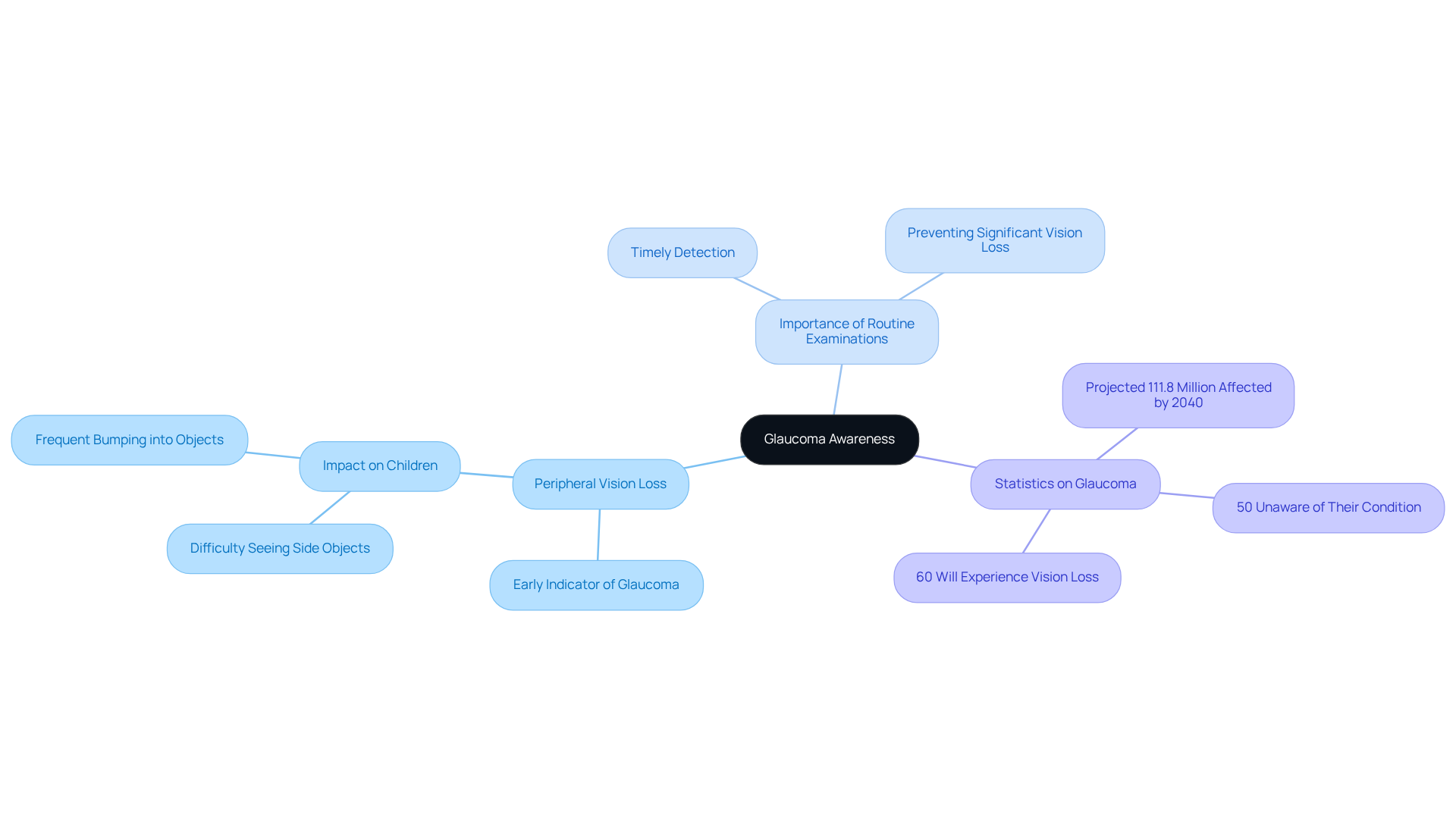
Seeing Halos Around Lights: A Symptom to Watch For
The presence of halos or rainbow-hued rings around lights in young individuals can be a significant indicator of . This symptom often arises from , which may become more noticeable in low-light conditions or at night. Research shows that halos are not merely a nuisance; they can be and indicate underlying eye health concerns that require prompt attention. For instance, a study found that:
- 39% of patients with eye pressure issues reported seeing halos
- 46% noted glare as a symptom
This highlights the of the signs of glaucoma.
As parents, it’s essential to be vigilant if you notice such changes in your child’s vision. Consulting an in a timely manner is crucial for identifying signs of glaucoma. play a vital role in swiftly identifying and treating eye conditions, including signs of glaucoma, ensuring that any potential problems are addressed without delay. often undergo that can lead to early diagnoses, allowing for effective management. According to Yvette C. Terrie, BSPharm, RPh, ” are key to protecting eyesight.” By understanding that can indicate a serious eye condition, parents can seek the necessary medical help, ultimately safeguarding their children’s vision.

Eye Pain: A Potential Sign of Glaucoma
Intense , particularly when accompanied by symptoms like nausea or vomiting, can signal a serious issue related to . We understand that seeing your child in distress can be alarming, and it’s important for parents to be vigilant for any signs of . This may necessitate immediate medical attention to prevent serious complications. If left unaddressed, acute eye pressure can lead to irreversible vision loss. Studies indicate that often experience ocular discomfort, highlighting the importance of .
With this condition affecting approximately in the U.S., awareness of these indicators is vital for parents to ensure their child’s eye health is prioritized. Moreover, this eye condition is a , and about 50% of those affected are unaware they have it due to a lack of early symptoms. Experts emphasize that understanding the nuances of eye discomfort in young ones is crucial, as taking prompt action can significantly improve outcomes.
Jeff Todd, President and CEO of Prevent Blindness, underscores the for individuals experiencing vision loss. He stresses that resources must be allocated to assist the growing number of patients in receiving the essential care they need. Remember, we are here to help you through this process.
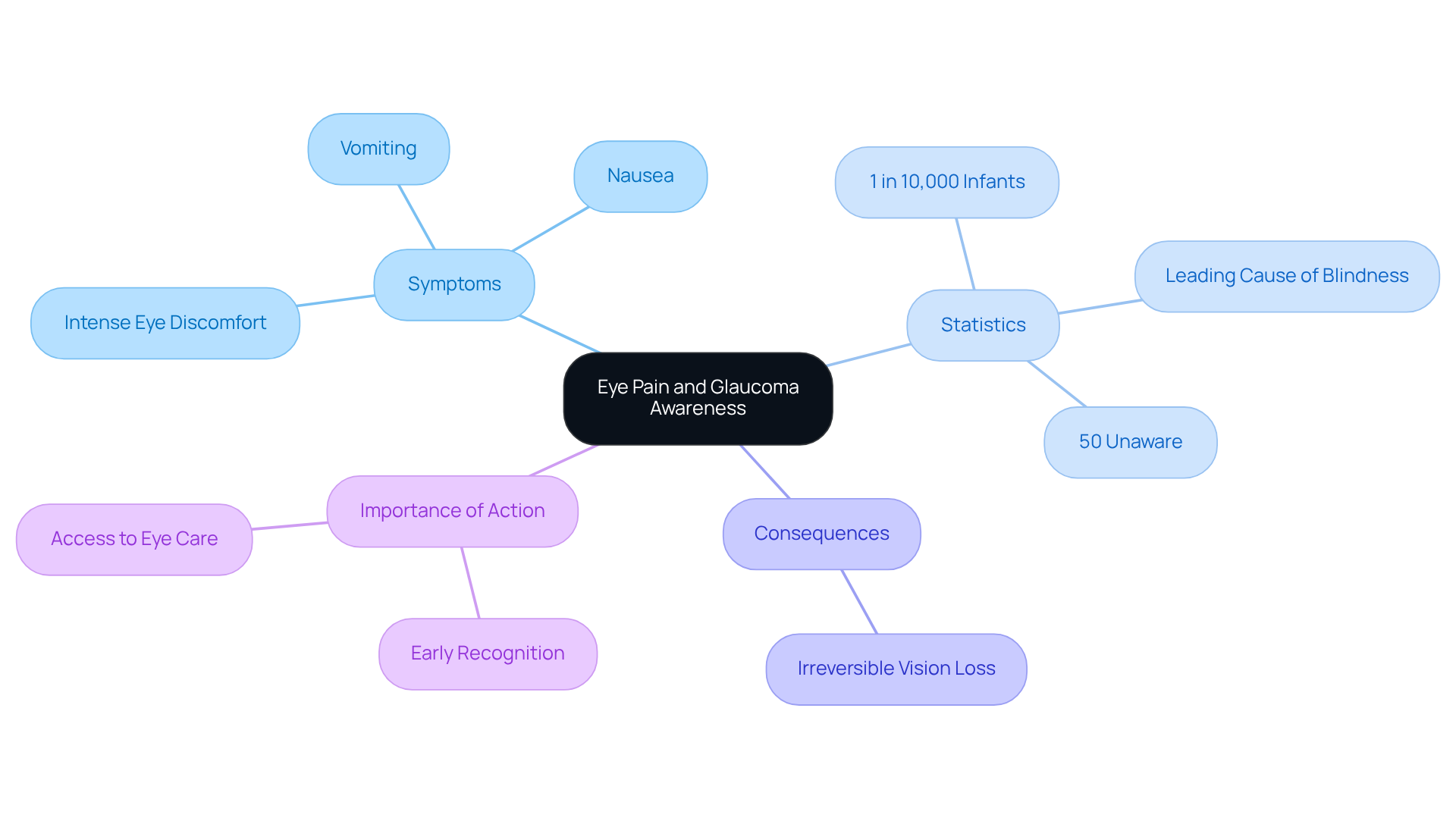
Headaches: A Possible Indicator of Glaucoma
Regular headaches, especially those that seem to originate from the eye area, can be significant related to in young individuals. We understand that as parents, you may feel concerned if your child reports persistent headaches; these could be indicating underlying eye pressure issues that need immediate attention. Research shows that children experiencing eye pressure problems often suffer from headaches, which may be linked to elevated intraocular pressure (IOP). In fact, headaches associated with eye pressure issues can manifest as intense pain, visual disturbances, or sensitivity to light, highlighting the importance of checking for signs of glaucoma during a thorough eye examination.
Recognizing these symptoms early is crucial for your child’s health. Dr. Gregory Cox emphasizes that , as they may indicate serious eye issues such as increased intraocular pressure, which requires careful observation to prevent vision impairment. He notes, “Most forms of the condition advance quietly, indicating that patients may undergo gradual vision loss without any warning signs like head pain.” Furthermore, research indicates that , including signs of glaucoma, making it vital for guardians to be proactive in seeking eye care.
Real-life examples highlight the importance of this vigilance. In cases where young individuals exhibited frequent headaches, follow-up assessments revealed undiagnosed eye conditions, underscoring the necessity for . Alarmingly, approximately 50% of cases of this eye condition in communities remain undiagnosed, reinforcing the need for proactive eye care. By understanding the connection between headaches and eye pressure issues, you can recognize the signs of glaucoma and take steps to prioritize your child’s eye health, leading to timely interventions and improved outcomes. Additionally, signs of glaucoma, which include , such as sudden eye pain and visual disturbances, should never be overlooked.
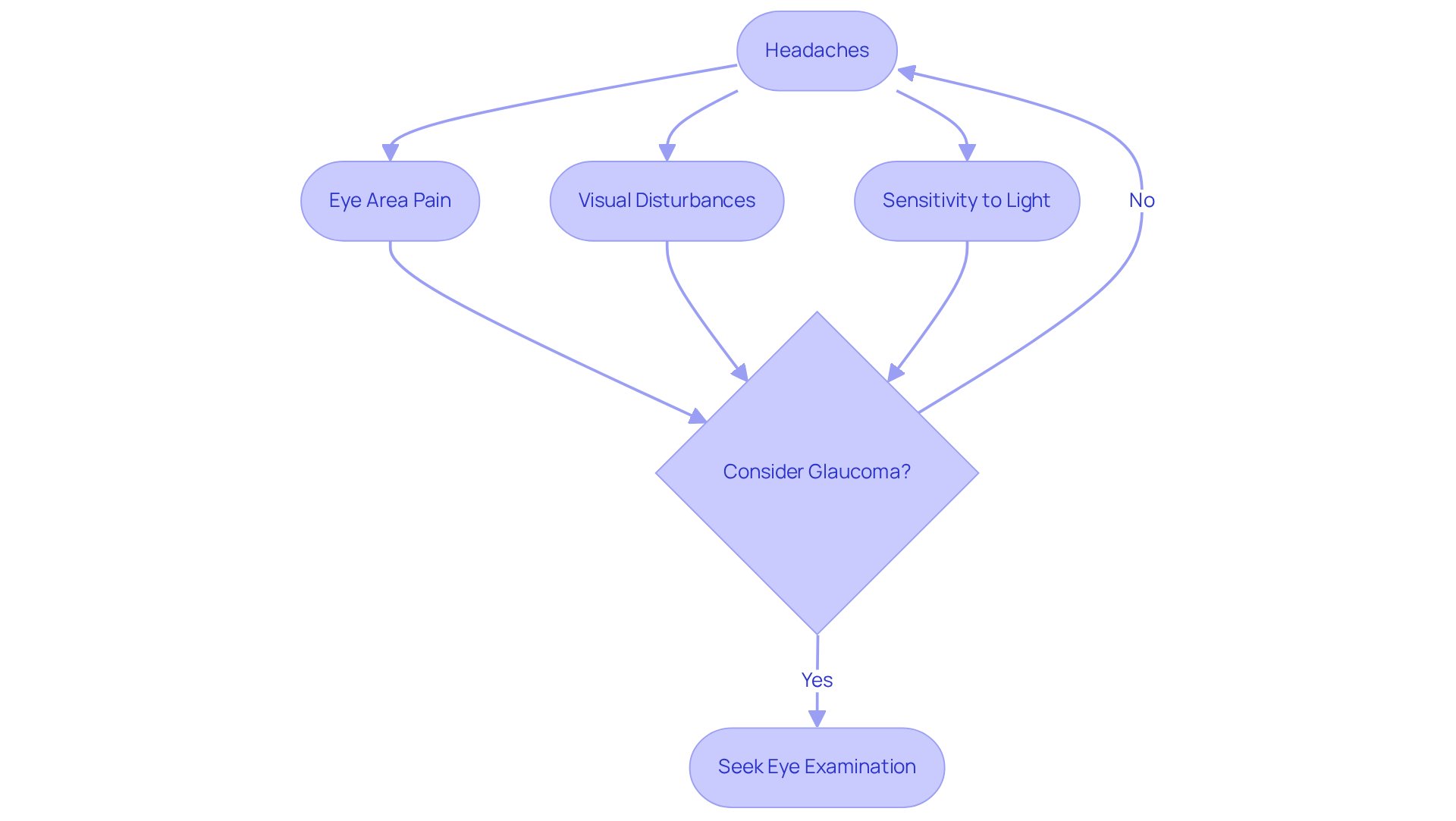
Sudden Vision Changes: A Red Flag for Glaucoma
Sudden changes in vision, such as a rapid decline in clarity or the emergence of blind spots, are that should not be overlooked. We understand that as a parent, noticing these symptoms can be concerning. It’s essential to act quickly and seek prompt medical attention if your child exhibits signs of glaucoma, as these may indicate or other serious conditions that require urgent intervention.
Research indicates that early detection is vital. Untreated acute eye pressure conditions can lead to . In fact, the in at least one eye from eye disease was 26.5% after 10 years. This underscores the importance of . Approximately 42.2% of patients with have experienced significant vision impairment by their last visit, highlighting the risks associated with delayed treatment.
Recognizing the signs of glaucoma is crucial for of young individuals. We are here to help you through this process and ensure that your child receives the care they need. Remember, acting swiftly can make all the difference in safeguarding their vision.
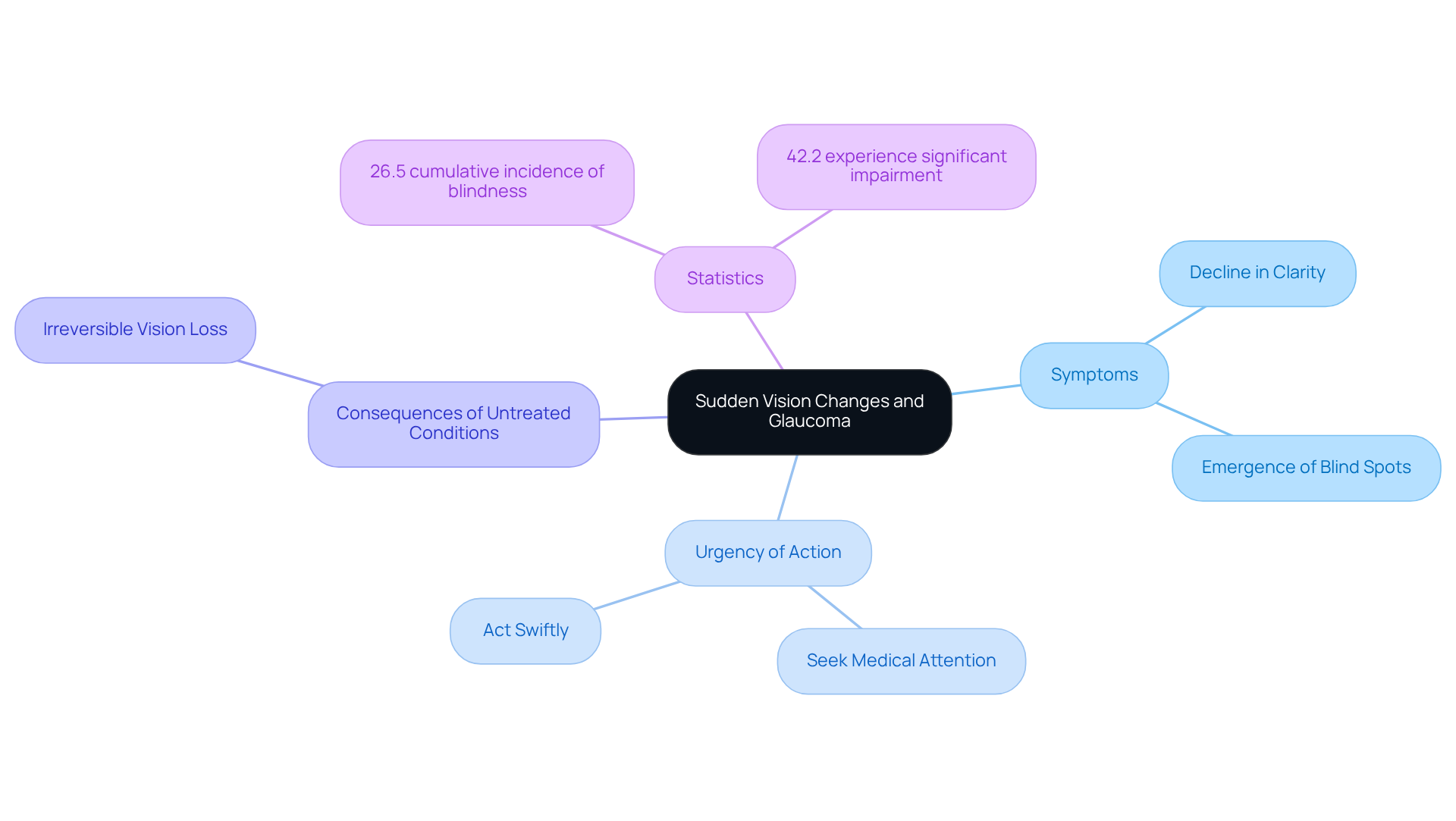
Light Sensitivity: An Early Symptom of Glaucoma
Heightened sensitivity to light, known as photophobia, can be an early indicator of in young individuals. This condition may present as frequent squinting or a , which can prompt parents to take notice. Studies indicate that photophobia affects 15-50% of individuals with eye pressure concerns, particularly among younger patients. For instance, children diagnosed with [eye pressure issues](https://nweyeclinic.com/?p=5729) often exhibit discomfort in brightly lit environments, significantly impacting their daily activities.
We understand that can be concerning for parents. Expert opinions underscore the importance of timely identification. Dr. Davinder Grover emphasizes, ” is crucial for managing glaucoma effectively.” It’s essential for parents to stay alert for , as excessive tearing, cloudy corneas, or difficulty focusing may accompany photophobia, all of which could indicate that there are [signs of glaucoma](https://glaucoma.org/articles/early-warning-signs-of-childhood-glaucoma-a-guide-for-parents) related to elevated intraocular pressure.
Real-life instances highlight the importance of prompt detection. Parents who have sought medical attention upon noticing their child’s often experience better outcomes, thanks to timely diagnosis and treatment that can preserve vision. at the first sign of these behaviors can lead to prompt intervention, ultimately enhancing the individual’s quality of life and visual health. Given the rarity of childhood eye pressure issues, being aware and detecting symptoms early is vital for effective management. Regular follow-ups after treatment are also crucial, as Robert Feldman, MD, points out, to ensure ongoing care and monitoring.

Regular Eye Exams: Essential for Early Glaucoma Detection
Routine eye assessments are essential for the of , particularly for youngsters who might be at risk. We understand that as parents, you want the best for your children’s health. The American Optometric Association advises that youngsters undergo their at six months, followed by another at age three, and then yearly starting at the beginning of each school year. These are vital for identifying any changes in eye health early, including signs of glaucoma, enabling timely intervention and treatment.
Research shows that over one in 20 preschoolers and one in four school-aged individuals experience a . It’s concerning to note that less than 15 percent of preschoolers have an eye exam conducted by a professional. Furthermore, studies indicate that 70 to 80 percent of vision problems are missed by school vision screenings. This underscores the necessity of to ensure your child’s vision is properly assessed.
Timely identification through these tests can greatly lower the likelihood of developing serious issues such as amblyopia, which impacts roughly 2 percent of youngsters aged six months to six years. If not addressed, this can result in irreversible vision loss. By adhering to these guidelines, you can play a pivotal role in safeguarding your children’s vision and overall eye health. We are here to help you through this process, ensuring your child receives the .
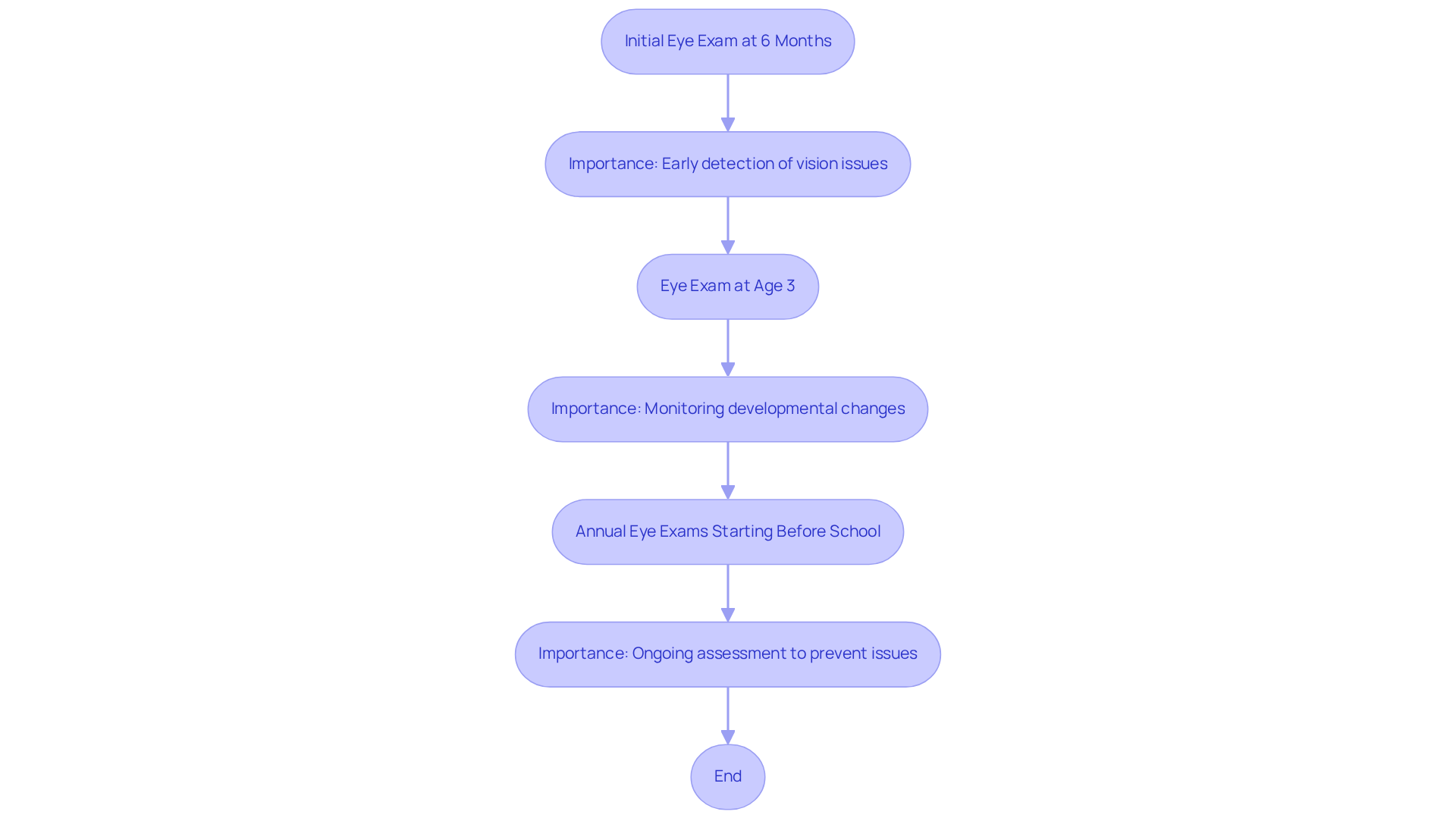
Conclusion
Recognizing the signs of glaucoma is crucial for safeguarding the vision of children. Early detection can significantly alter the course of this often-silent disease. We understand that as parents, you play a vital role in monitoring your children’s eye health, and it’s important to be vigilant about the symptoms that may indicate glaucoma, such as:
- Blurred vision
- Increased eye pressure
- Light sensitivity
Understanding these indicators not only enhances awareness but also encourages timely medical intervention, which is essential for effective management and treatment.
Throughout this article, we have emphasized the importance of regular eye examinations. These assessments can reveal early signs of glaucoma that might otherwise go unnoticed. From peripheral vision loss to headaches and sudden changes in vision, each symptom serves as a potential red flag that should prompt immediate attention. The staggering statistics surrounding glaucoma’s prevalence and its impact on the economy further underscore the necessity for proactive eye care.
Ultimately, prioritizing eye health through routine check-ups and being alert to any changes in vision can make a significant difference in preventing irreversible damage. We encourage you to take action, ensuring your children receive the comprehensive eye care they deserve. By fostering an environment of awareness and vigilance, the risk of glaucoma can be mitigated, paving the way for healthier vision in the future.
Frequently Asked Questions
Why are comprehensive eye exams important for glaucoma detection?
Comprehensive eye exams are crucial for the timely identification of signs of glaucoma and other eye pressure conditions. They include evaluations of intraocular pressure, visual field tests, and optic nerve analysis, allowing for early intervention before symptoms escalate.
How common is glaucoma, and why is early detection important?
Approximately 4.22 million people in the U.S. are affected by glaucoma, with many unaware of their condition. Early detection is essential to enhance the chances of receiving a prompt diagnosis and effective management, which helps preserve vision and reduces associated medical costs.
What symptoms should parents be aware of regarding their children’s eye health?
Parents should be vigilant for symptoms such as blurred vision, which can indicate potential signs of glaucoma and other eye conditions. Prompt medical attention is necessary if a child experiences difficulties in concentrating or seeing objects clearly.
What role does elevated intraocular pressure (IOP) play in glaucoma?
Elevated IOP is a critical sign of glaucoma, particularly in young individuals. Routine eye exams that include tonometry can accurately measure IOP, facilitating early detection and management of potential eye conditions.
What is the financial impact of glaucoma on the healthcare system?
Glaucoma costs the U.S. approximately $2.86 billion each year in medical expenses and lost productivity, highlighting the importance of early detection not only for individual health but also for broader economic considerations.
What should individuals over 40 or with a family history of eye disease do?
Individuals over 40 or those with a family history of eye disease are encouraged to arrange for thorough eye examinations to ensure early detection and management of potential eye conditions.






